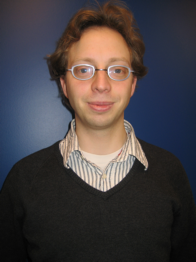Nonlinear Scattering and Propagation of Ultrashort Pulses – Examples of Modeling and Applications
Promotion date: 29. January 2010
Promotor: Prof. Dr. Klaus Boller
Assistant Promotor: Dr. Chris Lee
| Various types of nonlinear interaction of ultrashort light pulses with matter are described with a focus on finding applications through the use of numerical models and experimental validation. -The efficiency of Second Harmonic Generation within a powder is used to obtain the orientation of the crystal axes. This information is used to obtain the mean size of the particles. -By using numerical models two strategies were formulated to combine CARS spectroscopy with sub-diffraction limited imaging techniques. -Also several novel nonlinear all-optical interaction mechanisms have been discovered using such numerical models. Such an interaction has been shown to function as an all-optical XOR-gate which might be used as a component for all-optical computing. |
Was there a special moment during your thesis project that was important for your outcomes?
I remember one afternoon, I had a two hours discussion with my supervisor, when two of the main ideas of the thesis became clear, after a period of straying between subjects. This kind of moments is of great importance. It is hard, if not impossible, to control the moment such a crucial finding takes place. Within a few days it already became clear, that these chosen routes were very promising.
Here, the initial idea of studying laser physics and its interaction with material properties, became more alive. First of all, I was better equipped to study the phenomena and I had a better understanding of the direction of investigations that were feasible and promising. On the other hand, in the group the optical research line was more pronounced by the arrival of a post-doc investigator. It was inspiring to work together. Also the connection with professor Fallnich, from Münster University and professor Herek from the UT was important, especially on the subject of combining CARS with sub-diffraction-limited imaging.
When did it become clear, you did find some valuable results?
In CARS spectroscopy one experiences fundamental limitations, for example in the imaging of fat particles in cells. The diffraction limit in optical measurement methods, lies in the vicinity of 0,5 µm. Using special mechanisms to compensate these limitations, by means of advanced numerical methods, we succeeded in constructing two types of imaging techniques going beyond these limitations.
During a talk in München, initially I was a little nervous. Professor Stephan Hell, a leading scientist on the subject, was one of the spokespersons too. His instruments are already used in measurement equipment. After my contribution, he came up to me to congratulate and show his appreciation. Also, on this subject, I had some publications in Optics Express and Physical Review A.
What are your future plans?
Since the 1st of October I am working with the spin-off company Lionix. Here, my knowledge of numerical methods of optics is important as well. Although different, the challenges are comparably interesting, using a different set of game rules, so to say. Here the main goal is to realize the products clients ask for. Also the discovery of new techniques is important, as these investigations are supported by European subsidies.
The use of numerical models and calculations, is a way of working that suits me very well. By logical thinking and smart simulation one can obtain results very quickly. Hereafter, one can perform promising experiments, which remain necessary, of course.

